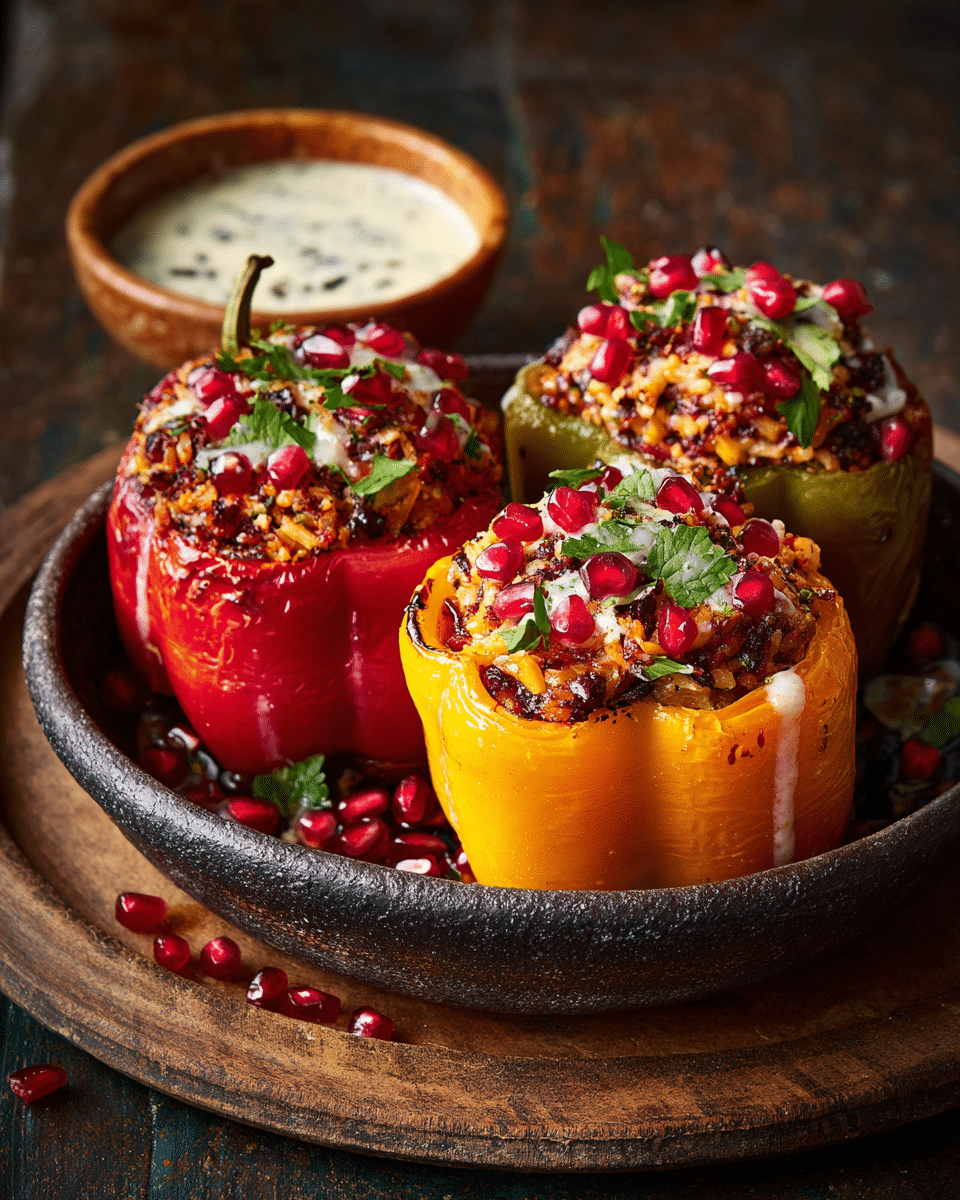Chiles en Nogada is one of Mexico’s most iconic and festive dishes, traditionally served during the month of September to celebrate Mexican Independence Day. Its vibrant colors green from the poblano peppers, white from the creamy walnut sauce (nogada), and red from the pomegranate seeds represent the Mexican flag.
FULL RECIPE
Ingredients
1.For the Chiles:
- 6 large poblano peppers
- 2 tablespoons vegetable oil
2.For the Picadillo (Filling):
- 1 pound ground beef (or half beef and half pork)
- 2 tablespoons vegetable oil
- 1 medium onion, finely chopped
- 2 cloves garlic, minced
- 2 medium tomatoes, finely chopped
- 1 medium apple, peeled and diced
- 1 medium pear, peeled and diced
- 1 medium peach, peeled and diced
- 1/2 cup raisins
- 1/4 cup slivered almonds
- 1/2 teaspoon ground cinnamon
- 1/4 teaspoon ground cloves
- 1/4 teaspoon ground nutmeg
- Salt and pepper to taste
3.For the Nogada (Walnut Sauce):
- 1 cup fresh walnuts, peeled and soaked in milk for at least 2 hours
- 1/2 cup milk (plus more if needed for consistency)
- 1/2 cup Mexican crema or sour cream
- 1/4 cup queso fresco, crumbled
- 1 tablespoon sugar
- Salt to taste
4.For Garnish:
- 1/2 cup pomegranate seeds
- Fresh parsley leaves
Directions
- Prepare the Chiles: Roast poblano peppers directly over an open flame or under a broiler, turning until skins are charred and blistered. Place them in a plastic bag to steam for 10 minutes, then peel off skins carefully. Make a small slit along one side and remove seeds, keeping peppers intact.
- Cook the Filling: In a large skillet, heat vegetable oil over medium heat. Add onion and garlic, sautéing until softened. Add ground meat and cook until browned, breaking it apart with a spoon.
- Stir in tomatoes and cook until softened. Add apple, pear, peach, raisins, and almonds. Mix in cinnamon, cloves, nutmeg, salt, and pepper. Simmer for 10–15 minutes, allowing flavors to meld.
- Stuff the Peppers: Carefully spoon the picadillo filling into each poblano pepper, ensuring they hold their shape.
- Prepare the Nogada Sauce: Drain soaked walnuts and place them in a blender with milk, crema, queso fresco, sugar, and a pinch of salt. Blend until smooth and creamy, adding more milk if necessary for desired consistency.
- Assemble the Dish: Place stuffed chiles on a serving platter. Spoon nogada sauce generously over each chile.
- Garnish: Sprinkle with pomegranate seeds and top with fresh parsley leaves for a patriotic presentation. Serve immediately at room temperature.
Nutrition Facts
- Calories: 480
- Protein: 20g
- Fat: 32g
- Saturated Fat: 10g
- Carbohydrates: 32g
- Fiber: 6g
- Sugars: 20g
- Cholesterol: 75mg
- Sodium: 380mg
Historical Significance of Chiles en Nogada
Chiles en Nogada holds a special place in Mexico’s cultural and culinary history. Originating in the state of Puebla, it is said to have been created in 1821 by the nuns of the Santa Monica convent to honor Agustín de Iturbide, a key figure in Mexico’s independence. The dish’s colors—green from the poblano pepper, white from the walnut sauce, and red from the pomegranate seeds—mirror the Mexican flag, making it a patriotic symbol. Traditionally served in September during Independence Day celebrations, it’s not just food but an edible expression of national pride and identity.
Flavor Profile and Culinary Balance
One of the most remarkable qualities of Chiles en Nogada is its intricate flavor harmony. The savory richness of the picadillo filling blends perfectly with the natural sweetness of the fruits and raisins, while the warm spices such as cinnamon and cloves add depth. The creamy nogada sauce introduces a nutty sweetness that contrasts beautifully with the slight bitterness of the roasted poblano peppers. Finally, the burst of freshness from the pomegranate seeds provides a bright, tangy finish, ensuring every bite is a symphony of flavors.
Nutritional Benefits
While Chiles en Nogada is considered a festive indulgence, it offers some noteworthy nutritional benefits. The poblano peppers are rich in vitamins A and C, supporting immune health and vision. The walnut-based nogada sauce contains healthy fats, omega-3s, and antioxidants, promoting heart health. The fruits in the filling provide natural fiber and vitamins, while the lean ground meat offers high-quality protein. Although it’s a calorie-dense dish due to the creamy sauce, its nutrient diversity makes it a balanced option when enjoyed in moderation.
Regional Variations Across Mexico
Although the classic Puebla-style recipe is the most well-known, variations of Chiles en Nogada can be found across Mexico. In some regions, cooks use different proteins such as shredded chicken or even vegetarian fillings with mushrooms and lentils. Some adapt the nogada sauce to be less sweet, while others add extra spices for a bolder kick. Even the fruits can vary depending on local availability—guava, plantain, or figs may replace the traditional apple, pear, and peach combination. Each variation offers a unique interpretation while staying true to the dish’s festive essence.
Pairing Suggestions for a Complete Meal
The richness of Chiles en Nogada makes it an ideal centerpiece for a celebratory meal. Traditional accompaniments include Mexican white rice or a fresh green salad to balance the flavors. It pairs wonderfully with a crisp white wine such as Sauvignon Blanc or a light, fruity rosé. For a more traditional touch, a glass of agua fresca made from seasonal fruits like guava or watermelon complements the dish’s sweetness. To end the meal, a light dessert such as flan or tres leches cake works beautifully without overpowering the palate.
Serving Presentation for Maximum Impact
Presentation plays a vital role in Chiles en Nogada, as its visual appeal is part of its charm. The peppers are typically served at room temperature, generously covered in the creamy walnut sauce so that only the stem is visible. A generous sprinkle of jewel-like pomegranate seeds is added on top, followed by fresh parsley leaves for a vibrant contrast. The goal is to create a plate that looks like a miniature version of the Mexican flag, making it as much a feast for the eyes as for the taste buds.
Common Preparation Challenges and Tips
Making Chiles en Nogada can be a labor of love due to the multiple components that need careful preparation. One common challenge is peeling poblano peppers without tearing them, which requires proper roasting and steaming to loosen the skins. Achieving the perfect nogada sauce consistency can also be tricky—too thick and it overpowers the dish, too thin and it fails to coat properly. The filling should be cooked slowly to allow the flavors to meld without becoming soggy. Planning ahead and preparing components separately can make the process smoother.
Storage and Reheating Advice
Because Chiles en Nogada is often prepared in large quantities for gatherings, proper storage is important. The stuffed peppers can be refrigerated without the nogada sauce for up to three days in an airtight container. The walnut sauce should be stored separately and only added just before serving to maintain its creamy texture and prevent discoloration. For reheating, it’s best to warm the peppers gently in an oven rather than a microwave to preserve their structure, then top with room-temperature sauce before garnishing.
Cultural Rituals and Festive Traditions
Serving Chiles en Nogada is often accompanied by cultural traditions, especially in Puebla during September’s patriotic celebrations. Families gather to prepare the dish together, with each member taking on a role—roasting peppers, chopping fruit, or blending the sauce. The dish is sometimes enjoyed with music, dancing, and storytelling, making it more than just a meal. In restaurants, it may be served with elaborate table settings, and in some towns, culinary festivals are held where chefs compete to present the most beautiful and delicious version.
Modern Adaptations and Dietary Alternatives
With evolving dietary preferences, Chiles en Nogada has been reimagined in creative ways. Vegan versions replace ground meat with lentils, quinoa, or plant-based protein crumbles, while dairy-free nogada sauces use coconut cream or almond milk. For those watching sugar intake, the fruit content can be reduced or substituted with lower-sugar options. Chefs have also experimented with plating techniques, serving deconstructed versions where each component is presented separately for a contemporary twist. These adaptations make the dish more inclusive while keeping its celebratory spirit alive.
Conclusion
Chiles en Nogada is far more than just a recipe—it is a cultural treasure that embodies Mexico’s history, traditions, and culinary artistry. From its patriotic colors to its layered flavors, it reflects a blend of indigenous ingredients and European influences that tell a story on every plate. While it requires patience and care to prepare, the result is a showstopping dish that delights both the eyes and the palate.






